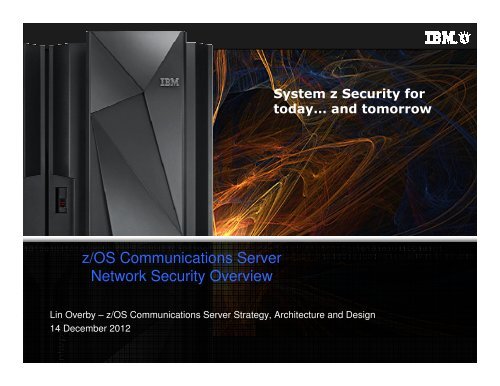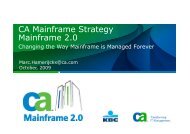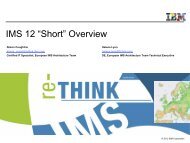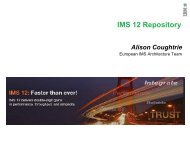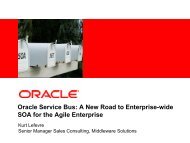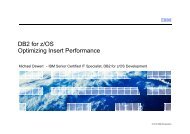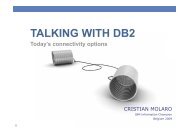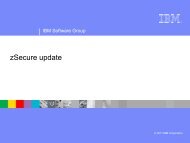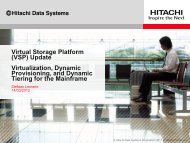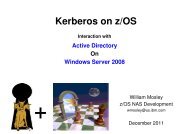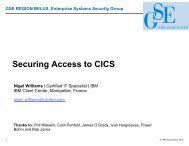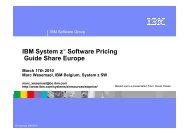z/OS Communications Server Network Security Overview - GSE Belux
z/OS Communications Server Network Security Overview - GSE Belux
z/OS Communications Server Network Security Overview - GSE Belux
You also want an ePaper? Increase the reach of your titles
YUMPU automatically turns print PDFs into web optimized ePapers that Google loves.
z/<strong>OS</strong> <strong>Communications</strong> <strong>Server</strong><br />
<strong>Network</strong> <strong>Security</strong> <strong>Overview</strong><br />
System z <strong>Security</strong> for<br />
today… and tomorrow<br />
Lin Overby – z/<strong>OS</strong> <strong>Communications</strong> <strong>Server</strong> Strategy, Architecture and Design<br />
14 December 2012
2<br />
Session abstract<br />
z/<strong>OS</strong> <strong>Communications</strong> <strong>Server</strong> <strong>Network</strong> <strong>Security</strong> <strong>Overview</strong><br />
Traditionally, network security has been placed at the enterprise perimeter.<br />
Enterprise security deployments are increasingly implemented with multiple<br />
layers of defense to protect mission critical data systems. While perimeterbased<br />
network security is still in force, the additional enablement of network<br />
security function at the server provides a critical layer of protection in the<br />
security infrastructure. This session will describe how z/<strong>OS</strong> Communication<br />
<strong>Server</strong> 'self-protects' z/<strong>OS</strong> from a network security perspective. Topics<br />
covered are drivers of network security function deployment into the server<br />
endpoint, as well as the policy-based network security solutions that are<br />
available on z/<strong>OS</strong>. The solution focus areas for this session include IPSec,<br />
Application Transparent TLS, integrated intrusion detection services, SAF<br />
protection of TCP/IP resource, centralized control of <strong>Communications</strong> <strong>Server</strong><br />
network security, and integration of DataPower with z/<strong>OS</strong> security using the<br />
<strong>Communications</strong> <strong>Server</strong> <strong>Network</strong> <strong>Security</strong> <strong>Server</strong>.<br />
System z security for today … and tomorrow
3<br />
Agenda<br />
• <strong>Overview</strong><br />
– Roles and objectives<br />
– Deployment trends and requirements<br />
• Policy-based <strong>Network</strong> <strong>Security</strong><br />
– IP security (IP packet filtering and IPSec)<br />
– Application Transparent TLS<br />
– Intrusion Detection Services<br />
• Enterprise-wide <strong>Security</strong> Roles<br />
– Centralized Policy Agent<br />
– <strong>Network</strong> <strong>Security</strong> Services<br />
• SAF Protection of TCP/IP Resources<br />
– SERVAUTH profiles for TCP/IP<br />
System z security for today … and tomorrow
4<br />
Agenda<br />
• <strong>Overview</strong><br />
– Roles and objectives<br />
– Deployment trends and requirements<br />
• Policy-based <strong>Network</strong> <strong>Security</strong><br />
– IP security (IP packet filtering and IPSec)<br />
– Application Transparent TLS<br />
– Intrusion Detection Services<br />
• Enterprise-wide <strong>Security</strong> Roles<br />
– Centralized Policy Agent<br />
– <strong>Network</strong> <strong>Security</strong> Services<br />
• SAF Protection of TCP/IP Resources<br />
– SERVAUTH profiles for TCP/IP<br />
System z security for today … and tomorrow
5<br />
Role of network security on System z<br />
Secure access<br />
to both TCP/IP<br />
and SNA<br />
applications<br />
Focus on<br />
end-to-end<br />
security and<br />
self-protection<br />
Exploit<br />
strengths of<br />
System z<br />
hardware and<br />
software<br />
Business<br />
Partner<br />
Enterprise <strong>Network</strong><br />
or Intranet<br />
• Protect data and other resources on the system<br />
from the network<br />
– System availability<br />
• Protect system against unwanted<br />
access and denial of service attacks<br />
from network<br />
– Identification and authentication<br />
• Verify identity of network users<br />
– Access control<br />
• Protect data and other system<br />
resources from unauthorized access<br />
Secure Key Distribution<br />
Secure protocols<br />
(IPSec, SSL, SNA SLE)<br />
with Strong Encryption<br />
Internet<br />
System z security for today … and tomorrow<br />
F<br />
I<br />
R<br />
E<br />
W<br />
A<br />
L<br />
L<br />
IBM<br />
Remote<br />
Access<br />
IBM<br />
IBM<br />
F<br />
I<br />
R<br />
E<br />
W<br />
A<br />
L<br />
L<br />
IBM<br />
<strong>Network</strong><br />
IDS<br />
Enterprise <strong>Network</strong><br />
or Intranet<br />
IBM<br />
Intranet<br />
Host<br />
RACF for<br />
User I&A<br />
Access Ctl<br />
Mission-critical data<br />
z/<strong>OS</strong><br />
<strong>Communications</strong><br />
<strong>Server</strong><br />
z/<strong>OS</strong> CS<br />
IDS<br />
• Protect data in the network using cryptographic<br />
security protocols<br />
– Data endpoint authentication<br />
• Verify who the secure end point claims to be<br />
– Data origin authentication<br />
• Verify that data was originated by claimed<br />
sender<br />
– Message Integrity<br />
• Verify contents were unchanged in transit<br />
– Data Privacy<br />
• Conceals cleartext using encryption
Recent network security deployment trends and requirements<br />
6<br />
Self-protection will increase in importance and will evolve into the last layer deployed in a<br />
total defense in depth strategy. The server (and client) will become the “new perimeter” as<br />
more security function is pushed into the endpoints, either because more security is required<br />
or because the endpoint is the only place the function can be performed.<br />
• More “defense in depth” deployments<br />
– <strong>Security</strong> no longer perimeter based<br />
– <strong>Server</strong> is last layer in defense in depth<br />
• Driven by regulatory compliance and more stringent IT security policies<br />
– Many new industry and government standards (PCI DSS, HIPAA, SOX, etc.)<br />
– Driving many enterprises to adopt new security practices<br />
– Data privacy is a common theme – drives end-to-end network crypto<br />
• Increasing adoption of network security in servers<br />
– Seeing increasing deployment of both IPSec and TLS on z/<strong>OS</strong><br />
– “Self-protect” features such as IP packet filtering (“personal firewall” on server), IDS<br />
• Focus on minimizing security deployment costs<br />
– Application transparent network security reduces application costs<br />
– Policy-based network security reduces deployment costs<br />
– GUI-based policy administration for ease of use<br />
System z security for today … and tomorrow
7<br />
Protocol layer view of TCP/IP security technologies<br />
Protect the system Protect data in the network<br />
z/<strong>OS</strong> CS TCP/IP applications use SAF<br />
to authenticate users and prevent<br />
unauthorized access to datasets, files,<br />
and SERVAUTH protected resources.<br />
The SAF SERVAUTH class is used to<br />
prevent unauthorized user access to<br />
TCP/IP resources (stack, ports, networks).<br />
Intrusion detection services protect<br />
against attacks of various types on the<br />
system's legitimate (open) services. IDS<br />
protection is provided at both the IP and<br />
transport layers.<br />
IP packet filtering blocks out all IP<br />
traffic that this system doesn't<br />
specifically permit. These can be<br />
configured or can be applied<br />
dynamically as “defensive filters”.<br />
Application layer<br />
SAF protection<br />
Application specific<br />
Native<br />
SSL / TLS<br />
API layer<br />
SAF protection<br />
AT-TLS<br />
IDS<br />
IDS<br />
IP Filtering<br />
IPSec<br />
Kerberos<br />
TCP/UDP transport layer<br />
IP <strong>Network</strong>ing layer<br />
System z security for today … and tomorrow<br />
Examples of application protocols with built-in<br />
security extensions are SNMPv3 and <strong>OS</strong>PF.<br />
Both Kerberos and SSL/TLS are located as extensions<br />
to the sockets APIs and applications have to be<br />
modified to make use of these security functions. Both<br />
SSL/TLS and Kerberos are connection-based and only<br />
applicable to TCP (stream sockets) applications, not<br />
UDP.<br />
AT-TLS is a TCP/IP stack service that provides<br />
SSL/TLS services at the TCP transport layer and is<br />
transparent to applications.<br />
IP packet filters specify traffic that requires IPSec.<br />
IPSec resides at the networking layer and is<br />
transparent to upper-layer protocols, including both<br />
transport layer protocol and application protocol.
8<br />
Agenda<br />
• <strong>Overview</strong><br />
– Roles and objectives<br />
– Deployment trends and requirements<br />
• Policy-based <strong>Network</strong> <strong>Security</strong><br />
– IP security (IP packet filtering and IPSec)<br />
– Application Transparent TLS<br />
– Intrusion Detection Services<br />
• Enterprise-wide <strong>Security</strong> Roles<br />
– Centralized Policy Agent<br />
– <strong>Network</strong> <strong>Security</strong> Services<br />
• SAF Protection of TCP/IP Resources<br />
– SERVAUTH profiles for TCP/IP<br />
System z security for today … and tomorrow
9<br />
Policy-based network security on z/<strong>OS</strong> overview<br />
• Policy is created through Configuration<br />
Assistant for z/<strong>OS</strong> <strong>Communications</strong><br />
<strong>Server</strong><br />
– GUI-based tool<br />
– Configures each security discipline (AT-TLS,<br />
IP<strong>Security</strong> and IDS) using consistent model<br />
– Generates and uploads policy files to z/<strong>OS</strong><br />
• Policy Agent processes and installs<br />
policies into TCP/IP stack<br />
– Policies are defined per TCP/IP stack<br />
– Separate policies for each discipline<br />
– Policy agent also monitors and manages the<br />
other daemons and processes needed to<br />
enforce the policies (IKED, syslogd, trmd, etc.)<br />
• Provides network security without<br />
requiring changes to your applications<br />
– <strong>Security</strong> policies are enforced by TCP/IP stack<br />
– Different security disciplines are enforced<br />
independent of each other<br />
System z security for today … and tomorrow<br />
TCP/IP<br />
Application<br />
Sockets API<br />
Transport<br />
AT-TLS<br />
IP<strong>Security</strong><br />
<strong>Security</strong> policy<br />
administrator<br />
<strong>Network</strong>ing<br />
DLC<br />
IDS<br />
IDS Policy<br />
AT-TLS<br />
Policy<br />
Policy Agent<br />
IP<strong>Security</strong><br />
Policy
10<br />
Configuration Assistant for z/<strong>OS</strong> <strong>Communications</strong> <strong>Server</strong><br />
System z security for today … and tomorrow<br />
• Configures:<br />
– AT-TLS<br />
– IPSec and IP filtering<br />
– IDS<br />
– Quality of Service<br />
– Policy-based routing<br />
• Separate perspectives but<br />
consistent model for each<br />
discipline<br />
• Focus on concepts, not details<br />
– What traffic to protect<br />
– How to protect it<br />
– De-emphasize low-level details<br />
(though they are accessible<br />
through advanced panels)<br />
• z/<strong>OS</strong>MF-based web interface<br />
(strategic) or downloadable<br />
standalone Windows<br />
application<br />
• Builds and maintains<br />
– Policy files<br />
– Related configuration files<br />
– JCL procs and RACF directives<br />
• Supports import of existing<br />
policy files
11<br />
IP <strong>Security</strong><br />
System z security for today … and tomorrow
z/<strong>OS</strong> IP <strong>Security</strong> support<br />
• z/<strong>OS</strong> IP <strong>Security</strong> is a complete IP filtering, IPSec, and IKE solution and is part of z/<strong>OS</strong><br />
<strong>Communications</strong> <strong>Server</strong><br />
• Services<br />
– Protect the system from the network<br />
• IP filtering to control which packets can enter the system<br />
– Protect against data leakage from the system<br />
• IP filtering to control which packets can leave the system<br />
– Cryptographic protection of data in the network<br />
• Manual IPSec (statically defined security associations)<br />
• Dynamic negotiation of IPSec security associations using Internet Key Exchange (IKE)<br />
– Filter directed logging of IP <strong>Security</strong> actions to syslogd<br />
12<br />
Client<br />
Enterprise <strong>Network</strong><br />
or Intranet F<br />
Internet<br />
System z security for today … and tomorrow<br />
I<br />
R<br />
E<br />
W<br />
A<br />
L<br />
L<br />
F<br />
I<br />
R<br />
E<br />
W<br />
A<br />
L<br />
L<br />
Enterprise <strong>Network</strong><br />
or Intranet<br />
IPSec traffic<br />
Non-IPSec traffic<br />
z/<strong>OS</strong>
13<br />
IP packet filtering overview<br />
• IP filtering at the z/<strong>OS</strong> IP Layer<br />
– Filter rules defined based on attribute of IP packets:<br />
• IPv4 or IPv6 source/destination address<br />
• Protocol (TCP, TCP with ACK, UDP, ICMP, etc.)<br />
• Source/destination Port<br />
• Direction of flow<br />
• Local or routed traffic<br />
• Time<br />
• <strong>Network</strong> interface<br />
– Used to control<br />
• Traffic being routed<br />
• Access at destination host (local)<br />
– Possible actions when a filter rule is matched:<br />
• Permit<br />
• Deny<br />
• Permit with IPSec protection<br />
• Log (in combination with above actions)<br />
• IP filter rules are defined within IP<strong>Security</strong> policy<br />
– This policy also controls IPSec if you choose to use it<br />
– Rudimentary “default rules” can also be defined in TCPIP<br />
profile to provide protection before policy agent initializes<br />
• Benefits for local traffic (self-protection):<br />
– Early discard of potentially malicious packets<br />
– Avoid wasting CPU cycles checking validity of packets for<br />
applications that are not supported on this system<br />
System z security for today … and tomorrow<br />
Applications<br />
TCP/UDP<br />
IPv4 & IPv6<br />
Interfaces<br />
Applications<br />
TCP/UDP<br />
IPv4 & IPv6<br />
Interfaces<br />
Routed Traffic<br />
Local Traffic<br />
Filter policy<br />
• Traffic routed through this<br />
TCP/IP stack<br />
Filter policy<br />
• Traffic going to or coming<br />
from applications on this<br />
TCP/IP stack only
14<br />
IPSec overview<br />
IPSec<br />
Applications<br />
TCP/UDP<br />
IP/ICMP<br />
Data Link<br />
<strong>Network</strong><br />
• Provides authentication, integrity, and data privacy via IPSec security protocols<br />
– Authentication Header (AH) - provides authentication / integrity<br />
– Encapsulating <strong>Security</strong> Protocol (ESP) - provides data privacy with authentication /<br />
integrity<br />
• Implemented at the IP layer<br />
– Requires no application change<br />
– Secures traffic between any two IP resources - <strong>Security</strong> Associations (SA)<br />
• Management of crypto keys and security associations can be:<br />
– Manual<br />
– Dynamically negotiated via Internet Key Exchange (IKE) based on IP security policy<br />
System z security for today … and tomorrow<br />
Applications<br />
TCP/UDP<br />
IP/ICMP<br />
Data Link
15<br />
z/<strong>OS</strong> IPSec security features<br />
• A complete IPSec implementation<br />
– Authentication Header (AH) and Encapsulating <strong>Security</strong><br />
Payload (ESP) <strong>Security</strong> Associations (SAs)<br />
– Transport and Tunnel Mode<br />
– Supports host and gateway roles (optimized for host role)<br />
– IKE version 1 and version 2 (RFC 5996)<br />
• Wide range of modern cryptographic algorithms including<br />
AES (multiple modes), SHA2, SHA1, RSA, ECDSA, etc.<br />
• zIIP assisted<br />
– Moves IPSec processing from general CPs to zIIPs<br />
– All inbound IPSec traffic and a good portion of outbound<br />
IPSec traffic is processed on a zIIP processor<br />
• Supports NAT Traversal and NAPT for IPv4<br />
• Sysplex-wide <strong>Security</strong> Associations allow SAs to be shared<br />
across the sysplex<br />
• IP <strong>Security</strong> monitoring interface: IBM Tivoli OMEGAMON XE<br />
for Mainframe <strong>Network</strong>s<br />
System z security for today … and tomorrow<br />
encrypted<br />
IPSec policy<br />
administrator<br />
NSS<br />
Daemon<br />
Sockets API<br />
Transport<br />
<strong>Network</strong>ing<br />
IPv4, IPv6<br />
DLC<br />
IKE<br />
Daemon<br />
IP filters + IPSec<br />
IPSec<br />
policy<br />
Allows z/<strong>OS</strong> to participate<br />
in a wide range of VPN<br />
topologies and interoperates<br />
with a wide variety of IPSec<br />
implementations.
IPSec Scenarios and z/<strong>OS</strong> Roles<br />
16<br />
Host-to-Host: End-to-End <strong>Security</strong> Association<br />
z/<strong>OS</strong><br />
H1<br />
H1 Internet/ H2<br />
intranet<br />
Connection<br />
Gateway-to-Host:<br />
Protection over Untrusted <strong>Network</strong> Segment<br />
z/<strong>OS</strong><br />
intranet G1 Internet/ G2 intranet H2<br />
intranet<br />
Connection Tunnel mode IPSec SA<br />
z/<strong>OS</strong> as Host (Data Endpoint)<br />
Transport mode IPSec SA<br />
z/<strong>OS</strong><br />
System z security for today … and tomorrow<br />
H1<br />
Gateway-to-Gateway:<br />
Protection over Untrusted <strong>Network</strong> Segment<br />
z/<strong>OS</strong><br />
H1<br />
Connection<br />
Internet/<br />
intranet<br />
Legend<br />
Data endpoint<br />
<strong>Security</strong> endpoint<br />
Host-to-gateway: Protect segment of data path<br />
Connection<br />
intranet<br />
G1 Internet/ G2<br />
intranet<br />
z/<strong>OS</strong> as Gateway (Routed Traffic)<br />
intranet<br />
Tunnel mode IPSec SA<br />
intranet G1 G2 intranet H2<br />
Tunnel mode IPSec SA<br />
H2
17<br />
Application Transparent TLS<br />
System z security for today … and tomorrow
Transport Layer <strong>Security</strong> enablement<br />
18<br />
TLS<br />
Encrypted<br />
Applications<br />
System SSL API<br />
Sockets<br />
TCP<br />
IP <strong>Network</strong>ing Layer<br />
<strong>Network</strong> Interfaces<br />
• TLS traditionally provides security services as a socket layer service<br />
– TLS requires reliable transport layer,<br />
• Typically TCP (but architecturally doesn’t have to be TCP)<br />
– UDP applications cannot be enabled with traditional TLS<br />
• There is now a TLS variant called Datagram Transport Layer <strong>Security</strong> (DTLS) which is<br />
defined by the IETF for unreliable transports<br />
• On z/<strong>OS</strong>, System SSL (a component of z/<strong>OS</strong> Cryptographic Services) provides an API<br />
library for TLS-enabling your C and C++ applications<br />
• Java Secure Sockets Extension (JSSE) provides libraries to enable TLS support for Java<br />
applications<br />
– However, there is an easier way…<br />
TLS/SSL<br />
<strong>Network</strong><br />
… Application Transparent TLS!<br />
System z security for today … and tomorrow<br />
Applications<br />
System SSL API<br />
Sockets<br />
TCP<br />
IP <strong>Network</strong>ing Layer<br />
<strong>Network</strong> Interfaces
19<br />
z/<strong>OS</strong> Application Transparent TLS overview<br />
• Stack-based TLS<br />
– TLS process performed in TCP layer (via System SSL)<br />
without requiring any application change (transparent)<br />
– AT-TLS policy specifies which TCP traffic is to be TLS<br />
protected based on a variety of criteria<br />
• Local address, port<br />
• Remote address, port<br />
• Connection direction<br />
• z/<strong>OS</strong> userid, jobname<br />
• Time, day, week, month<br />
• Application transparency<br />
– Can be fully transparent to application<br />
– Applications has option to inspect or control certain<br />
aspects of AT-TLS processing – “application-aware”<br />
and “application-controlled” AT-TLS, respectively<br />
• Available to TCP applications<br />
– Includes CICS Sockets<br />
– Supports all programming languages except PASCAL<br />
• Supports standard configurations<br />
– z/<strong>OS</strong> as a client or as a server<br />
– <strong>Server</strong> authentication (server identifies self to client)<br />
– Client authentication (both ends identify selves to<br />
other)<br />
• Uses System SSL for TLS protocol processing<br />
– Remote endpoint sees an RFC-compliant<br />
implementation<br />
– Interoperates with other compliant implementations<br />
System z security for today … and tomorrow<br />
Optional<br />
APIs for<br />
applications<br />
to inspect or<br />
control<br />
aspects of<br />
TLS session.<br />
encrypted<br />
AT-TLS policy<br />
administrator<br />
using<br />
Configuration<br />
Assistant<br />
TCP/IP<br />
Application<br />
Sockets API<br />
Transport (TCP)<br />
AT-TLS<br />
System SSL<br />
<strong>Network</strong>ing<br />
IPv4, IPv6<br />
DLC<br />
AT-TLS<br />
policy
20<br />
Some z/<strong>OS</strong> applications that use AT-TLS<br />
• <strong>Communications</strong> <strong>Server</strong> applications<br />
– TN3270 <strong>Server</strong><br />
– FTP Client and <strong>Server</strong><br />
– CSSMTP<br />
– Load Balancing Advisor<br />
– IKE NSS client<br />
– NSS server<br />
– Policy agent<br />
• DB2 DRDA<br />
System z security for today … and tomorrow<br />
• IMS-Connect<br />
• JES2 NJE<br />
• Tivoli Netview applications<br />
– MultiSystem Manager<br />
– NetView Management Console<br />
• RACF Remote Sharing Facility<br />
• CICS Sockets applications<br />
• 3 rd Party applications<br />
• Customer applications
Advantages of using AT-TLS<br />
21<br />
• Reduce costs<br />
– Application development<br />
• Cost of System SSL integration<br />
• Cost of application’s TLS-related configuration support<br />
– Consistent TLS administration across z/<strong>OS</strong> applications<br />
– Gain access to new features with little or no incremental<br />
development cost<br />
• Complete and up-to-date exploitation of System SSL features<br />
– AT-TLS makes the vast majority of System SSL features<br />
available to applications<br />
– AT-TLS keeps up with System SSL enhancements – as new<br />
features are added, your applications can use them by changing<br />
AT-TLS policy, not code<br />
• Ongoing performance improvements<br />
Focus on efficiency in use of System SSL<br />
• Great choice if you haven’t already invested in System SSL integration<br />
Even if you have, consider the long-term cost of keeping up vs. short term<br />
cost of conversion<br />
System z security for today … and tomorrow
<strong>Server</strong> authentication only<br />
<strong>Server</strong> + client authentication<br />
z/<strong>OS</strong> AT-TLS Supported Roles Data endpoint<br />
22<br />
<strong>Server</strong> and<br />
Trusted CA's<br />
Certificate<br />
<strong>Server</strong> and<br />
Trusted CA's<br />
Certificate<br />
Optional:<br />
Client certificate<br />
to RACF userid<br />
mapping for<br />
SAFCHECK<br />
z/<strong>OS</strong> TLS <strong>Server</strong><br />
RACF<br />
Keyring<br />
H1 Internet/ H2<br />
intranet<br />
z/<strong>OS</strong> TLS <strong>Server</strong> TLS Client<br />
RACF<br />
Keyring<br />
z/<strong>OS</strong> as <strong>Server</strong> z/<strong>OS</strong> as Client<br />
Connection TLS Session<br />
H1 Internet/ H2<br />
intranet<br />
TLS Client<br />
Connection TLS Session<br />
Trusted<br />
CA's<br />
Certificate<br />
Keyring<br />
Client and<br />
Trusted<br />
CA's<br />
Certificate<br />
Keyring<br />
System z security for today … and tomorrow<br />
<strong>Server</strong> and<br />
Trusted CA's<br />
Certificate<br />
Keyring<br />
<strong>Server</strong> and<br />
Trusted CA's<br />
Certificate<br />
TLS <strong>Server</strong><br />
Legend<br />
<strong>Security</strong> endpoint<br />
z/<strong>OS</strong> TLS Client<br />
H1 Internet/ H2<br />
intranet<br />
Connection TLS Session<br />
TLS <strong>Server</strong> z/<strong>OS</strong> TLS Client<br />
H1 Internet/ H2<br />
intranet<br />
Trusted<br />
CA's<br />
Certificate<br />
RACF<br />
Keyring<br />
Client and<br />
Trusted<br />
CA's<br />
Certificate<br />
Keyring RACF<br />
Connection<br />
Keyring<br />
TLS Session
23<br />
IPSec* and AT-TLS comparison<br />
Attribute<br />
Traffic covered<br />
Provides true end-to-end protection<br />
Provides network segment<br />
protection<br />
Protection scope<br />
Requires application modifications<br />
Endpoints and authentication<br />
Auth credentials<br />
Session key refresh<br />
IPsec<br />
All IP traffic (TCP, UDP, ICMP, etc.)<br />
Yes<br />
Yes<br />
Flexible (all traffic, single protocol,<br />
single or range of connections,<br />
etc.)<br />
No<br />
IP node to IP node<br />
(dynamic tunnels only) X.509<br />
certificates or pre-shared keys<br />
Configurable based on data and<br />
time.<br />
* - using IKE to establish IPsec tunnels dynamically<br />
System z security for today … and tomorrow<br />
AT-TLS<br />
TCP connections<br />
Yes<br />
No<br />
Single TCP connection<br />
No, unless advanced function<br />
needed<br />
Application to application<br />
X.509 certificates<br />
Configurable based on time.
24<br />
Intrusion Detection Services<br />
System z security for today … and tomorrow
Protecting against intentional and unintentional attacks<br />
on your system<br />
• What is an intrusion?<br />
– Information Gathering<br />
• <strong>Network</strong> and system topology<br />
• Data location and contents<br />
– Eavesdropping/Impersonation/Theft<br />
• On the network/on the host<br />
• Base for further attacks on others<br />
through Amplifiers, Robots, or Zombies<br />
– Denial of Service - Attack on availability<br />
• Single packet attacks - exploits system or<br />
application vulnerability<br />
• Multi-packet attacks - floods systems to<br />
exclude useful work<br />
• Attacks can occur from Internet or intranet<br />
– Company firewalls and intrusion prevention<br />
appliances can provide some level of<br />
protection from Internet<br />
– Perimeter security strategy alone may not be<br />
sufficient.<br />
• Some access is permitted from Internet –<br />
typically into a Demilitarized Zone (DMZ)<br />
• Trust of intranet<br />
• Attacks can be intentional (malicious) but<br />
often occur as a result of errors on nodes in<br />
the network (config, application, etc.)<br />
25<br />
External<br />
attacker<br />
System z security for today … and tomorrow<br />
Internal<br />
end-user<br />
attacker<br />
Intrusion Detection and<br />
Prevention<br />
Packet filtering<br />
Enterprise<br />
Enterprise<br />
network<br />
network<br />
or<br />
or<br />
intranet<br />
intranet<br />
Company Firewall<br />
Public<br />
Public<br />
network<br />
network<br />
or<br />
or<br />
Internet<br />
Internet<br />
Zombie<br />
attacker
26<br />
z/<strong>OS</strong> <strong>Communications</strong> <strong>Server</strong> IDS overview<br />
IDS Policy<br />
administrator<br />
IDS<br />
Policy<br />
z/<strong>OS</strong> CS Policy<br />
infrastructure<br />
Attack!!!<br />
Applications<br />
TCP/UDP<br />
IPv4 & IPv6<br />
Interfaces<br />
Detailed event<br />
messages to<br />
z/<strong>OS</strong> UNIX<br />
System Services<br />
Syslogd<br />
Attack<br />
Probe<br />
Fires<br />
Trmdstat reporting or<br />
other auditing tools<br />
Syslogd<br />
Intrusion<br />
Event<br />
Notification<br />
Actions<br />
Selected event<br />
messages to<br />
MVS console<br />
CTRACE<br />
Dynamic packet<br />
trace of suspicious<br />
activity<br />
Defensive<br />
Actions<br />
System z security for today … and tomorrow<br />
Automation<br />
based on<br />
MVS console<br />
messages<br />
• Discard packet<br />
• Deny connection<br />
• Reset connection<br />
<strong>Security</strong><br />
Auditor<br />
<strong>Security</strong> Administrator<br />
MVS<br />
Console<br />
Operator<br />
<strong>Network</strong> Engineer<br />
– detailed P/D
27<br />
z/<strong>OS</strong> <strong>Communications</strong> <strong>Server</strong> IDS features<br />
IDS Events<br />
• Scans – attempts by remote nodes to discover<br />
information about the z/<strong>OS</strong> system<br />
• Attacks – numerous types<br />
• Malformed packets<br />
• IP option and IP protocol restrictions<br />
• Specific usage ICMP<br />
• Interface and TCP SYN floods<br />
• and so forth… including several new attack types<br />
introduced in V1R13<br />
• Traffic Regulation<br />
– TCP - limits the number of connections any<br />
given client can establish<br />
– UDP – limits the length of data on UDP<br />
queues by port<br />
z/<strong>OS</strong> in-context IDS broadens overall intrusion detection coverage:<br />
• Ability to evaluate inbound encrypted data - IDS applied after IPSec decryption on the target system<br />
• Avoids overhead of per packet evaluation against table of known attacks - IDS policy checked after attack<br />
probe fires<br />
• Detects statistical anomalies realtime - target system has stateful data / internal thresholds that generally are<br />
unavailable to external IDSs<br />
• Policy can control prevention methods on the target, such as connection limiting and packet discard<br />
System z security for today … and tomorrow<br />
Defensive actions<br />
• Packet discard<br />
• Limit connections<br />
• Drop connections (V1R13)<br />
Reporting<br />
• Logging<br />
• Console messages<br />
• IDS packet trace<br />
• Notifications to external<br />
event managers (like Tivoli<br />
NetView)
Defense Manager enables dynamic defensive actions<br />
28<br />
• The z/<strong>OS</strong> <strong>Communications</strong> <strong>Server</strong> Defense Manager component allows authorized users to<br />
dynamically install time-limited, defensive filters:<br />
– A local security administrator can install filters based on information received about a pending threat<br />
– Enables filter installation through automation based on analysis of current attack conditions<br />
• Defensive filtering is an extension to IDS capabilities<br />
– Adds additional defensive actions to protect against attacks<br />
z/<strong>OS</strong> <strong>Security</strong><br />
Administrator<br />
DM defensive<br />
filter database<br />
ipsec<br />
command<br />
z/<strong>OS</strong><br />
Defense<br />
Manager<br />
Maintain<br />
defensive<br />
filters<br />
Initial filters installed via TCP/IP<br />
Profile and/or Policy Agent<br />
ipsec<br />
command<br />
TCP,<br />
UDP<br />
System z security for today … and tomorrow<br />
IP<br />
Applications<br />
<strong>Network</strong><br />
Interfaces<br />
Filter<br />
rules<br />
IDS<br />
IDS<br />
Automation<br />
software<br />
Message<br />
processing<br />
Defensive filters…<br />
• DENY only<br />
• Limited lifetime (max ~2 weeks)<br />
• Installed "in-front" of<br />
configured/default filters<br />
• Maintained on DASD for<br />
availability in case of DM restart<br />
or stack start/restart<br />
• Scope may be:<br />
– Global - all stacks on the<br />
LPAR where DM runs<br />
– Local - apply to a specific<br />
stack<br />
• One Defense Manager per LPAR<br />
• Use of ipsec command to display<br />
and control defensive filters is<br />
secured via SAF security profiles
29<br />
Centralized Policy Agent<br />
and<br />
<strong>Network</strong> <strong>Security</strong> Services<br />
System z security for today … and tomorrow
<strong>Network</strong> <strong>Security</strong> Administration and Monitoring at Each System<br />
30<br />
z/<strong>OS</strong><br />
image 1<br />
Stack<br />
One<br />
z/<strong>OS</strong><br />
image n<br />
Stack<br />
One<br />
IKE<br />
Daemon<br />
...<br />
... ...<br />
IKE<br />
Daemon<br />
Certificates and<br />
private keys for<br />
image 1<br />
Stack<br />
Eight<br />
Certificates and<br />
private keys for<br />
image n<br />
Policy<br />
Agent<br />
Client<br />
Pagent.conf local policies<br />
Stack<br />
Eight<br />
RACF<br />
Keyring<br />
Policy<br />
Agent<br />
Client<br />
Pagent.conf local policies<br />
RACF<br />
Keyring<br />
Monitoring<br />
RACF certificate<br />
administration<br />
Configuration Assistant<br />
for z/<strong>OS</strong> Comm<strong>Server</strong><br />
System z security for today … and tomorrow<br />
• Each z/<strong>OS</strong> system locally<br />
administered<br />
– Monitoring<br />
– RACF certificate administration<br />
– Policy configuration<br />
• Connectivity required between<br />
administration and each managed<br />
platform<br />
– Monitoring application has advance<br />
knowledge of each managed node<br />
– Coordination required to push policy<br />
out to each system for deployment
Centralized networking security policy management<br />
LPAR1<br />
31<br />
Pagent.conf<br />
Stack<br />
One<br />
LPARn<br />
Pagent.conf<br />
Stack<br />
One<br />
Policy<br />
Agent<br />
Client<br />
...<br />
...<br />
Policy<br />
Agent<br />
Client<br />
...<br />
Optional local<br />
policies<br />
Stack<br />
Eight<br />
Optional local<br />
policies<br />
Stack<br />
Eight<br />
Secure connections<br />
Pagent.conf<br />
System z security for today … and tomorrow<br />
Stack<br />
One<br />
Policy<br />
Agent<br />
<strong>Server</strong><br />
...<br />
Stack<br />
Eight<br />
LPARx<br />
Centralized<br />
policies<br />
• <strong>Network</strong> security policy governs actions by<br />
security enforcement points<br />
– IPSec, TLS, IDS/IPS<br />
Centralized<br />
policy<br />
management<br />
• Policy agent roles<br />
– Centralized policy service provided by policy<br />
agent that has role of policy server<br />
– Policy agents that obtain policy from policy<br />
server have role of policy client<br />
– A single policy agent can be a policy client or<br />
policy server but not both
Centralized <strong>Network</strong> <strong>Security</strong> Services for IPSec<br />
32<br />
IPsec SAs<br />
IKE peer<br />
IPsec SAs<br />
z/<strong>OS</strong><br />
image 1<br />
iked.conf<br />
Stack<br />
One<br />
z/<strong>OS</strong><br />
image n<br />
iked.conf<br />
Stack<br />
One<br />
IKE<br />
Daemon<br />
IKE<br />
Daemon<br />
...<br />
Stack<br />
Eight<br />
System z security for today … and tomorrow<br />
..<br />
Stack<br />
Eight<br />
NSS role extended in z/<strong>OS</strong> V1R12<br />
NSS is required for z/<strong>OS</strong> V1R12 advanced certificate<br />
support<br />
Certificate Revocation List<br />
Certificate Trust Chain<br />
NSS is required for ALL IKEv2 certificate services<br />
secure<br />
connections<br />
nss.conf<br />
z/<strong>OS</strong> image x<br />
<strong>Network</strong><br />
<strong>Security</strong><br />
Services<br />
Daemon<br />
Certificates and<br />
private keys for<br />
images 1 to n<br />
SAF<br />
Keyring<br />
Centralized<br />
monitoring<br />
Centralized<br />
SAF certificate<br />
administration<br />
• Centralized IPSec network security<br />
services for a set of z/<strong>OS</strong> images<br />
– Images can be non-sysplex, within<br />
sysplex or cross sysplex<br />
• NSS digital signature services<br />
– Allows central administration of SAF<br />
certificates and private keys<br />
• Sign and verify during runtime IKE<br />
negotiations<br />
• NSS monitoring interfaces<br />
– Allows selection of single focal point as<br />
IPsec management hub<br />
• ipsec command for administrator<br />
• <strong>Network</strong> Monitor Interface (NMI) for<br />
management application
Extending NSS – Integrating<br />
DataPower with z/<strong>OS</strong> security<br />
DataPower<br />
Appliance<br />
(logical<br />
integration)<br />
DataPower<br />
XI50z<br />
Integrated<br />
Blade<br />
(physical<br />
integration)<br />
33<br />
Web<br />
Services<br />
request<br />
DataPower<br />
XML and Web<br />
Services<br />
processing<br />
SAF request<br />
NSS client<br />
DataPower<br />
DataPower<br />
• NSS XMLAppliance discipline enables both logical and physical integration<br />
between DataPower and z/<strong>OS</strong> security.<br />
• DataPower accesses centralized SAF services via z/<strong>OS</strong> NSS for:<br />
– SAF access service: Provides SAF-based authentication (of DP users) and<br />
access control (of DP resources) with SMF auditing<br />
– Certificate service: Provides retrieval of RSA certificates from a SAF keyring<br />
– Private key service provides:<br />
• Private RSA key retrieval (clear key only)<br />
• RSA signature and decryption operations (secure key only)<br />
• z/<strong>OS</strong> security administered through z/<strong>OS</strong> security facilities such as RACF<br />
(SAF), ICSF<br />
System z security for today … and tomorrow<br />
• WebSphere DataPower Appliances<br />
– Performs advanced WebServices operations<br />
– Message format transformation for traditional z/<strong>OS</strong> applications<br />
– Offloads XML and WebServices security function<br />
Secured TCP<br />
Connections<br />
z/<strong>OS</strong><br />
NSS <strong>Server</strong><br />
NSS Client<br />
infrastructure<br />
XMLAppliance<br />
Discipline<br />
SAF Access<br />
Service<br />
Certificate<br />
Service<br />
Private Key<br />
Service<br />
SMF<br />
Audit<br />
Records<br />
SMF<br />
RACF Profiles<br />
RACF<br />
ICSF<br />
RACF<br />
Keyring
34<br />
Agenda<br />
• <strong>Overview</strong><br />
– Roles and objectives<br />
– Deployment trends and requirements<br />
• Policy-based <strong>Network</strong> <strong>Security</strong><br />
– IP security (IP packet filtering and IPSec)<br />
– Application Transparent TLS<br />
– Intrusion Detection Services<br />
• Enterprise-wide <strong>Security</strong> Roles<br />
– Centralized Policy Agent<br />
– <strong>Network</strong> <strong>Security</strong> Services<br />
• SAF Protection of TCP/IP Resources<br />
– SERVAUTH profiles for TCP/IP<br />
System z security for today … and tomorrow
35<br />
SERVAUTH Protection for TCP/IP<br />
• All the "traditional" SAF protection of datasets, authorized MVS and z/<strong>OS</strong> UNIX functions, etc.<br />
on a z/<strong>OS</strong> system applies to TCP/IP workload just as it applies to all other types of workload.<br />
– Be careful with anonymous services such as anonymous FTP or TFTP services that can be<br />
configured to allow un-authenticated users access to selected MVS data sets and/or HFS files.<br />
• The SERVAUTH resource class is used to specifically define and protect a number of TCP/IP<br />
unique resources<br />
• General SERVAUTH profile format:<br />
EZB.resource_category.system_name.jobname.resource_name<br />
– EZB designates that this is a TCP/IP resource<br />
– resource_category is capability area to be controlled e.g. TN3270, Stack Access, etc.<br />
– system_name is the name of the system (LPAR) - can be wild-carded (*)<br />
– jobname is the jobname associated with the resource access request - can be wild-carded (*)<br />
– optional resource_name - one or more qualifiers to indicate name of resource to be<br />
protected - can be wild-carded (*)<br />
• To protect one of the supported TCP/IP resources, you define a SERVAUTH profile with<br />
universal access NONE and you then permit authorized user IDs to have READ access to the<br />
resource<br />
• If using OEM security packages, beware of the differences between defined/not defined<br />
resource actions<br />
System z security for today … and tomorrow
STACKACCESS<br />
36<br />
WEBSERV<br />
TCPIPA<br />
<strong>Network</strong><br />
security<br />
<strong>Network</strong><br />
zone<br />
security<br />
A<br />
zone<br />
A<br />
TSOUSR1<br />
TSOUSR2<br />
TCPIPB<br />
<strong>Network</strong><br />
security<br />
<strong>Network</strong><br />
zone<br />
security<br />
B<br />
zone<br />
B<br />
EZB.STACKACCESS.*.TCPIPA<br />
WEBSRV permitted, all others not<br />
EZB.PORTACCESS.*.TCPIPA.WEBPORT<br />
WEBSRV permitted, all others not<br />
EZB.NETACCESS.*.TCPIPB.ZONEC<br />
TSOUSR1 permitted, all others not<br />
<strong>Network</strong><br />
security<br />
<strong>Network</strong><br />
zone<br />
security<br />
C<br />
zone C<br />
System z security for today … and tomorrow<br />
• Limits local users’ open sockets or use of<br />
TCP/IP stack services (e.g., get hostname,<br />
get hostid, etc.)<br />
• Access to stack via sockets is allowed if<br />
the user has access to the following<br />
SERVAUTH class SAF resource:<br />
EZB.STACKACCESS.sysname.stackname<br />
• Define stack resource with UACC(NONE)<br />
and permit groups or individual users to<br />
allow them access to the stack<br />
• In the example, TSOUSR1 and TSOUSR2<br />
are not permitted to use TCPIPA
NETACCESS<br />
37<br />
WEBSERV<br />
TCPIPA<br />
<strong>Network</strong><br />
security<br />
<strong>Network</strong><br />
zone<br />
security<br />
A<br />
zone<br />
A<br />
TSOUSR1<br />
TSOUSR2<br />
TCPIPB<br />
<strong>Network</strong><br />
security<br />
<strong>Network</strong><br />
zone<br />
security<br />
B<br />
zone<br />
B<br />
EZB.STACKACCESS.*.TCPIPA<br />
WEBSRV permitted, all others not<br />
EZB.PORTACCESS.*.TCPIPA.WEBPORT<br />
WEBSRV permitted, all others not<br />
EZB.NETACCESS.*.TCPIPB.ZONEC<br />
TSOUSR1 permitted, all others not<br />
<strong>Network</strong><br />
security<br />
<strong>Network</strong><br />
zone<br />
security<br />
C<br />
zone C<br />
System z security for today … and tomorrow<br />
• Controls local user’s access to network resources<br />
• bind to local address<br />
• send/receive IP packets<br />
to/from protected zone<br />
•<strong>Network</strong><br />
•Subnet<br />
•Individual host<br />
(Note that firewalls can’t distinguish between individual<br />
users)<br />
• Access to security zone is allowed if the user has<br />
access to the SERVAUTH class SAF resource<br />
associated with the zone:<br />
EZB.NETACCESS.sysname.stackname.zonename<br />
• NETACCESS statement in TCP/IP profile defines<br />
security zones. For example, stack B may have:<br />
NETACCESS INBOUND OUTBOUND<br />
192.168.1.0 255.255.248.0 ZONEB<br />
192.168.0.0/16 ZONEC<br />
Default 0 WORLD<br />
ENDNETACCESS<br />
• In the example, TSOUSR2 is not permitted to network<br />
security zone C
38<br />
PORTACCESS<br />
WEBSERV<br />
TCPIPA<br />
<strong>Network</strong><br />
security<br />
<strong>Network</strong><br />
zone<br />
security<br />
A<br />
zone<br />
A<br />
TSOUSR1<br />
TSOUSR2<br />
TCPIPB<br />
<strong>Network</strong><br />
security<br />
<strong>Network</strong><br />
zone<br />
security<br />
B<br />
zone<br />
B<br />
EZB.STACKACCESS.*.TCPIPA<br />
WEBSRV permitted, all others not<br />
EZB.PORTACCESS.*.TCPIPA.WEBPORT<br />
WEBSRV permitted, all others not<br />
EZB.NETACCESS.*.TCPIPB.ZONEC<br />
TSOUSR1 permitted, all others not<br />
<strong>Network</strong><br />
security<br />
<strong>Network</strong><br />
zone<br />
security<br />
C<br />
zone C<br />
System z security for today … and tomorrow<br />
• Limits local users’ access to non-ephemeral<br />
ports<br />
• Controls whether a started task or userid can<br />
establish itself as a server on a given TCP or<br />
UDP port.<br />
• Access to use port is allowed if the user has<br />
access to the following SERVAUTH class SAF<br />
resource:<br />
EZB.PORTACCESS.sysname.stackname.SAFname<br />
• SAF keyword on PORT or PORTRANGE<br />
statement in TCP/IP profile defines SAF<br />
resource name. For example, stack A may<br />
have:<br />
PORT 80 TCP * SAF WEBPORT<br />
• In the example, only userid WEBSRV is<br />
permitted to establish itself as a server on port<br />
80 on stack TCPIPA
39<br />
SAF Protection: Other SERVAUTH resources<br />
There are 30+ different possible TCP/IP-related resource types to protect. Careful<br />
use of these can provide a significant level of security administrator-based control<br />
over use of TCP/IP-related resources on z/<strong>OS</strong><br />
• Command protection<br />
– ipsec<br />
– nssctl<br />
– pasearch<br />
– netstat<br />
• <strong>Network</strong> management APIs<br />
– packet trace<br />
– realtime SMF data<br />
– connection data<br />
• Application control<br />
See z/<strong>OS</strong> <strong>Communications</strong> <strong>Server</strong> IP Configuration Guide chapter 3 for a complete list of SERVAUTH profiles<br />
System z security for today … and tomorrow<br />
– broadcast socket options<br />
– IPv6 advanced socket APIs<br />
– NSS certificate, service, client access<br />
– FTP port, command access and HFS access<br />
– DCAS access<br />
• Other resource restrictions<br />
– Fast Response Cache Accelerator (FRCA) page load<br />
– SNMP subagent access<br />
– DVIPA modification control
40<br />
Summary<br />
System z security for today … and tomorrow
41<br />
Summary<br />
• Protecting system resources and data from the network<br />
– Integrated Intrusion Detections Services<br />
• Detects, records, and defends against scans, stack attacks, flooding<br />
– Protect system availability<br />
• Built in protection against Denial of Service attacks<br />
• IP packet filtering<br />
• Syslogd integrity and availability<br />
• Sysplex Wide <strong>Security</strong> Associations<br />
– SAF protection of z/<strong>OS</strong> resources<br />
• z/<strong>OS</strong> CS application access to data sets and files<br />
• SERVAUTH class protection<br />
• Protecting mission critical data in the network<br />
– True end-to-end security with security endpoint on z/<strong>OS</strong><br />
– Strong encryption with AES and Triple DES<br />
• Using hardware assist from crypto coprocessor and CP assist instruction<br />
– Transparent Application <strong>Security</strong><br />
• IPSec for TCP/IP applications<br />
• Application-Transparent TLS support<br />
• Internet-ready access to SNA applications with TN3270 SSL<br />
– Built-in Application <strong>Security</strong><br />
• Kerberized FTP, rsh, telnet,<br />
– Secure network services<br />
• SNMPv3, Secure <strong>OS</strong>PF Authentication, Secure DNS<br />
System z security for today … and tomorrow
42<br />
Thank you<br />
System z security for today … and tomorrow


